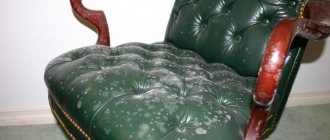What characteristics of furniture are considered for write-off?
When we talk about furniture, we mostly think about office furniture. Although this could also be the setting of retail or industrial premises, as well as catering premises.
General points for which furniture may be considered unsuitable for further use are:
- Partial or complete loss of basic mechanical functions:
- damage to legs, back, armrests, walls;
- deformation of the chair seat or work surface of the table;
- breakdown of mechanisms (for example, adjusting the height or tilt of the back of an office chair).
- Fatal appearance defects:
- indelible stains;
- noticeable defects in upholstery or painting (varnishing);
- Changes in color or durability of the upholstery (for example, as a result of exposure to sunlight).
NOTE! The furnishings of an office or restaurant hall are often the “face” of the owner company, so the role of appearance defects in determining the reasons for the write-off of a table or chair can be no less important than the loss of operational characteristics.
Reasons and formulations
A common reason why furniture in an organization is scrapped is usually because chairs, tables and other interior furnishings lose much of their useful features. As a result, their further exploitation becomes impossible. However, when drawing up documents for write-off, more specific characteristics and wording are required.
How to reflect in accounting the purchase of furniture accounted for as part of the inventory?
Considering the issue of writing off furniture further, let us turn to the rationale for these actions:
- Write-off due to breakdown or wear and tear. At the same time, financial and labor costs for repairs, elimination of breakdowns, and replacement of spare parts are close to the cost of a similar product on the market or even exceed it. It is clear that in such conditions it is more profitable to write off a piece of furniture and, possibly, dispose of the usable spare parts remaining after liquidation (for example, from an office chair).
- Write-off due to “obsolescence”, when property becomes obsolete when more modern models of similar property appear on the market, with more efficient performance characteristics. In relation to furniture, we can talk about the desire of management to find a new design solution for an office or workspace and complement the new design with appropriate furniture.
Here are the formulations that can be used when drawing up a write-off act in a particular case. Note that defects related to physical wear and tear (clause 1) can be divided into defects that prevent further operation and defects in appearance.
to reflect the write-off of furniture in accounting ?
Appearance defects:
- abrasions, faded areas, other color defects;
- defects in external coatings: mechanical damage to the upholstery, tears, damage to the paint layer of the surface;
- indelible stains.
Mechanical defects and damage:
- changes in the original shape of the product, surface deformations;
- breakdowns of mechanical parts of furniture that make this product unsuitable for use (mechanisms of office chairs, cabinets);
- breakdowns and loss of individual parts and main structures that impede further operation (handles, drawers, walls).
Operation with them present is impossible.
Important! All of the above reasons must be indicated in detail in the write-off act.
Examples of wording in the act:
- destruction of the varnish layer, the appearance of light spots on the varnish layer due to thermal, chemical effects of household chemical products;
- swelling of wooden parts and chipboard parts;
- corrosion of metal parts and components;
- loosening and unsticking of joints of furniture parts, appearance of cracks and gaps in joints due to their wear;
- mold damage to upholstery, facing materials, furniture flooring;
- formation of cracks, swelling, delamination on parts and components of the product, etc.
If you want to purchase new furniture and replace old furniture that does not have obvious defects, you can refer in the act to government decree No. 720 dated June 16, 1997. This document contains a list of durable goods that over time may pose a threat to the consumer. The manufacturer is obliged to set a service life for them. After the specified period, the products must be written off.
The list contains not only the names of upholstered and office furniture, but also various plumbing fixtures, including furniture (sets) for sanitary purposes.
The reason can be formulated as follows: “Written off due to the expired service life established by the manufacturer. According to Decree No. 720 of 06/16/97, it poses a potential threat to the health of workers and the environment. A technical passport indicating the service life is attached to the act.”
If the furniture is damaged
Furniture that is used in commercial premises, be it restaurants, hotels, offices, shops, factories, becomes unusable much earlier and more often than what happens with structures at home.
During intensive use, individual units may break down, become irreversibly dirty, tear, scratch, or fade. Data that such property has become unfit for use is recorded when compiling inventory papers or discovering similar facts.
The documentation shows the types of damage, for example:
- breakdown of the frame part, including legs, tabletops, seats, walls, armrests, doors;
- breakdown of the main functioning mechanisms that facilitated the operation of structures;
- deformation of individual elements as a result of excessive heating, high humidity, and wetness;
- wear of the upholstery as a result of the influence of the temporary factor;
- defects associated with facing furniture surfaces.
All these damages imply the need to write off and note these aspects in the act. There is one condition: the costs of restoration exceed the costs of purchasing new units . Information about how much repair work will cost can be obtained from organizations that specialize in this type of service.
DEFECTS RESULTING FROM VIOLATION OF FURNITURE STORAGE RULES IN WAREHOUSES
Furniture made from wood is very sensitive to changes in temperature and humidity in the room. The room in which furniture is stored must be dry, with heating and ventilation. The air temperature should be maintained within 18-20° C; relative air humidity is within 55-70%. When furniture is stored for a long time in a damp room, its varnished and polished surfaces become dull; air bubbles and roughness appear; planed (cladding) plywood is falling behind; doors and drawers swell; metal parts rust; Mold appears on the padding and covering material of upholstered furniture, and mold and dark stains appear on wicker furniture. At elevated temperatures and excessive dryness of the air in the room, the joints dry out and weaken; the gaps between the moving parts of the furniture increase and exceed the standards established by the technical specifications; wide massive parts crack; a number of parts, especially doors, cabinet sides, lids and table legs, are warped. The sun's rays discolor the front surfaces of furniture. A number of defects can also result from violation of the rules when arranging and stacking furniture in a warehouse. Installing furniture at a distance of less than 0.5 m from heating devices will cause the wood to dry out, and consequently, unsticking, cracking, and warping. When placing tables one on top of another without appropriate spacers under the legs, dents and abrasions form on the table tops. When more than 6 spring mattresses are stacked one on top of another, dents form on the surfaces of the mattresses from residual deformation of the springs and the tension of the facing fabric weakens. If the furniture is not covered with paper or covers, it will become dusty during long-term storage. When moving and carrying furniture carelessly inside the warehouse and during loading for shipment, scratches, abrasions, dents, nicks, fabric tears, etc. appear on the surface of the furniture.
If the furniture is suitable, but tired
The desire to change the environment is normal and natural not only for households, but also for entrepreneurs.
In this case, write-off occurs not because the furniture has lost its properties, but due to a change in the design concept of the object or the transition of the business to a new status with a higher level of prestige.
In such situations, they are guided by the service life of the furniture, which is established in the technical passport for it.
The write-off of office furniture due to the expiration of its service life, which was indicated in the technical documentation by the manufacturer, assumes the fact that it poses a threat and poses a danger to workers and other property. This process is carried out in accordance with the norms of the Government of the Russian Federation No. 720.
Causal factors are determined in a similar way . If, in the case of a breakdown, the write-off is carried out according to an amount comparable to the costs of repairs, then in this situation it is necessary to act according to the service life.
How to write off office furniture
Even fully depreciated furniture does not automatically leave the enterprise’s fixed assets. The basis for write-off is the act of the permanent inventory commission, the composition of which is approved by order of the head. Competent specialists are required to analyze the condition of the property, draw up a conclusion describing the problems and draw an appropriate conclusion about the feasibility of such a step.
The operation of writing off and recycling office furniture must be reflected in accounting and have a documentary basis and confirmation
This document may contain recommendations on the future fate of the furniture - subject to disposal, possible sale or gratuitous transfer to non-profit children's, civil, public organizations or individuals.
The act of loss of material objects does not have a uniform template, therefore it can be executed in any form provided for by the internal set of accounting policy rules. The write-off methodology is the same for all types of furniture, regardless of the reasons.
Sample defect report
There is no established template according to which the write-off procedure is carried out, so the enterprise has the opportunity to independently develop and approve it. The completed act must contain the following information :
- the name of the furniture structures that are being written off;
- total quantity (in units);
- identification codes and signs;
- the results of the inspection by a commission including senior employees of the organization;
- causative factors (breakage, deformation, defects);
- general conclusion;
- signatures belonging to responsible parties.
If we look at a specific example of a document, we can note that it includes several points :
- “Hat” , which indicates the word “I approve”, the name of the general director, and the date of compilation. Then it is signed with the word “Act” in the center, and the title of the document from a new line in the middle is “write-off of furniture, inventory, equipment.” All members of the commission are listed below, it is indicated that they examined certain pieces of furniture and found them to be written off on certain grounds.
- The basic part, represented by the table . The first column displays the name of the structures to be decommissioned. The second indicates the inventory number, then the unit of measurement, quantity. The last column is the general technical condition and causal factors.
- The final part begins below the table and includes the immediate conclusion, information about the group members, and results.
DEFECTS ARISING FROM VIOLATION OF FURNITURE TRANSPORTATION RULES
When transporting furniture, the rules established by the technical specifications must be strictly observed. When transporting over long distances by rail and water transport, furniture is wrapped in paper, matting or other similar material and packed in wooden cages made of wood with a moisture content of no more than 20%. There should be soft pads in places where the furniture comes into contact with the walls of the cage. Polished furniture is first wrapped in paper and then in dry straw or shavings. All metal parts of the furniture are lubricated with an easily removable thick lubricant before packaging. Metal parts of dismountable furniture are packaged separately in paper or placed in a cardboard box. Furniture is transported over short distances by road transport - regular trucks or specially equipped vans. When transporting furniture on ordinary trucks, soft pads are placed between the contacting parts, the furniture is tied with ropes and covered with a tarpaulin. When transported on vans, furniture is secured in them with special devices. As a result of non-compliance with the rules for packaging furniture during transportation, the following defects may appear. If the packaging crate is made of wood with a moisture content above 20%, the furniture will become damp, as a result of which the varnish film will fade, spots, roughness, air bubbles will appear on the finished surfaces, and doors and drawers will swell. If there are no soft pads in the places where the furniture comes into contact with the container, with each other or with the tie-down ropes, the furniture in these places will appear abrasions, chips, and dents. When transporting furniture in the rain without a tarpaulin, moisture that gets on the surface of the furniture will deteriorate the varnish film and white spots will appear.
Reasons for different types
The reasons for write-off largely depend on the type of furniture. Let's look at the most common of them.
Office chairs and armchairs
Among the reasons causing the need to write off office chairs and chairs, the following points :
- damage to the leg, back, armrest;
- seat deformation;
- faded upholstery;
- scratches and holes in the upholstery material;
- loss of aesthetic properties of wood.
- breakdown of fittings (mechanical parts);
- the formation of noticeable gaps due to weakening or unsticking of tenon elements;
- warping of doors, insert shelves;
- breakdown of fittings;
- darkening of varnish;
- darkening of wood;
- destruction of the structure of the material due to the appearance of stains (during exposure to chemicals), aging, fading;
- corrosion;
- damage to the facing material by mold
Carpet
Despite the fact that carpet is not technically furniture, it is subject to write-off according to the same principle as other structures discussed earlier. Reasons include discoloration, formation of bald spots, spots, and holes.
Curtains
More often than not, curtains are susceptible to fading due to exposure to sunlight . But other defects may also form, such as the appearance of spots and holes.
Cushioned furniture
upholstered furniture is also subject to write-off . Such procedures are carried out in hotels, sanatoriums, and boarding houses. Structures located in public areas quickly deteriorate due to active use and negligence of visitors and staff.
The reasons for write-off measures include wear of the upholstery, sagging springs, cracks and chips.
Of course, an unaesthetic interior can easily ruin the organization’s reputation and reduce the flow of clients. In this regard, write-offs must be carried out in a timely and competent manner .
How to draw up a write-off act?
There is no special form for the act of writing off furniture. A company or individual entrepreneur has the right to develop and use its own template for such a document. In this case, it is necessary to provide the following information in the act:
- a list of furniture items (and their exact quantity) to be written off;
- numbers according to the inventory list;
- description of the items being written off indicating any defects found;
- the reasons that led to the need for write-off;
- the commission's verdict on the need for write-off;
- signatures of the commission members, the person in charge of these items, and the head of the enterprise.
Readers can view a sample of such an act on our website.
***
Furniture at an enterprise should be written off if it has fallen into disrepair, the cost of restoring it exceeds the price of a new one, or further use is inappropriate for aesthetic reasons. A special commission is appointed to carry out write-off activities.
Similar articles
- How to fill out the act of writing off strict reporting forms?
- Sample order for write-off of fixed assets
- Order on the creation of a commission for writing off material assets
- OKVED office furniture
- Sample order for write-off of fixed assets








